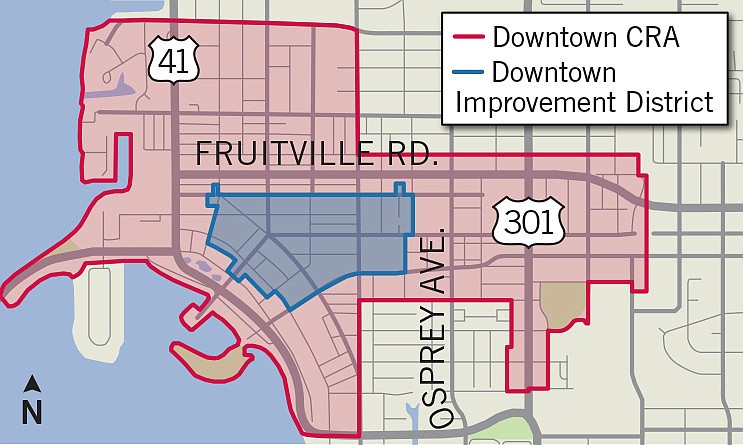- April 25, 2024
-
-
Loading

Loading

After funding a $1.9 million Main Street improvement project last year, the Downtown Improvement District has grappled with a new financial reality as it pays down the debt incurred from that undertaking.
At a November meeting, DID board members listed securing a new revenue stream as the group’s highest priority. Expanding the boundaries of the district — which draws its revenues from an additional tax on non-residential property owners — has been the most-discussed path to new money.
The group has talked about several possibilities for expansion. The most ambitious proposal would give the DID the same boundaries as the downtown Community Redevelopment Area. As a result, the DID would see its reach expand as far as the bayfront to the east, the Rosemary District to the north and Burns Square to the south.
Other options have included more modest expansions to the east, which would include businesses between Goodrich Avenue and U.S. 301. Projects the group has discussed funding with the additional revenue include conducting further street improvements, subsidizing downtown parking management, paying for additional security or funding a downtown circulator vehicle.
The potential expansion has been continuously discussed at DID meetings this year — yet no action has been taken. At its most recent meeting Tuesday, the group considered an even smaller expansion to Osprey Avenue. That move would bring in an additional $80,000 in revenue, doubling the group’s available annual budget, but it would still fall short of the roughly $400,000 projected cost of street improvements from Goodrich to Osprey.
John Moran, operations manager of the DID, said the group has yet to gauge the interest of adjoining property owners as part of any expansion.
“There has been none,” Moran said regarding contact with property owners outside of the district. “The board really has to decide what effort they want to conduct — what’s practical, what’s reasonable, who’s going to do it.”
The DID was created via an ordinance the City Commission passed in 2008. To convince the commission adequate support existed for the formation of the improvement district, Moran and City Commissioner Ken Shelin surveyed property owners in the area. Through the survey, they showed owners of at least 67% of the taxable value in the proposed DID supported an improvement district.
As the current DID board has discussed its future, it has been mentioned that demonstrating support for a significant expansion could be a tall order. Even Moran, who has encouraged more ambitious thinking from the DID, said going through the same process he went through on a larger scale would be difficult.

“In the case of the CRA boundaries, that would be quite a task,” Moran said. “There are 750 parcels in the CRA; that would seem to be impractical.”
Moran said it was possible that the City Commission could look at the work the DID has done to this point and, if it’s satisfied with it, use it as justification for expanding the boundaries. Still, he said, the DID board needs to plan how it would persuade officials to approve expansion.
Another reason the DID has not taken further steps toward expanding is that not everyone agrees it’s the right move. Board members Ron Soto and Tom Mannausa have said the group should focus on maintenance and improvement within the current boundaries. With work left to be done in the DID, they say, expansion talks are premature.
“Talking about spending money on a prospective expansion of the DID — I don’t think it’s worth the time in doing so when we have our own job with the 2 mills that have been paid through our property owners in the DID,” Mannausa said.
Board member Eileen Hampshire says she doesn’t believe expansion should take place just to find a new source of revenue. She agreed there’s more room for internal improvements, and thinks continuing to upgrade the current DID area would help woo property owners outside the district.
“I’d love to see us make what we’ve got so fabulous that they come to us and say, ‘Hey, we’ve got to join the DID,’” Hampshire said.
Moran was skeptical that, given the board’s current finances, it could make any significant upgrades that would sway other parties. Until the board provides more direction on the path it wants to take, the scale of the group’s operations will be reduced. In Moran’s eyes, there’s not much room to debate what path that should be.
“The top priority was expanding the resources of the DID,” Moran said. “There’s really only one sustainable way to do it, and that’s to increase its boundaries.”
Contact David Conway at [email protected]